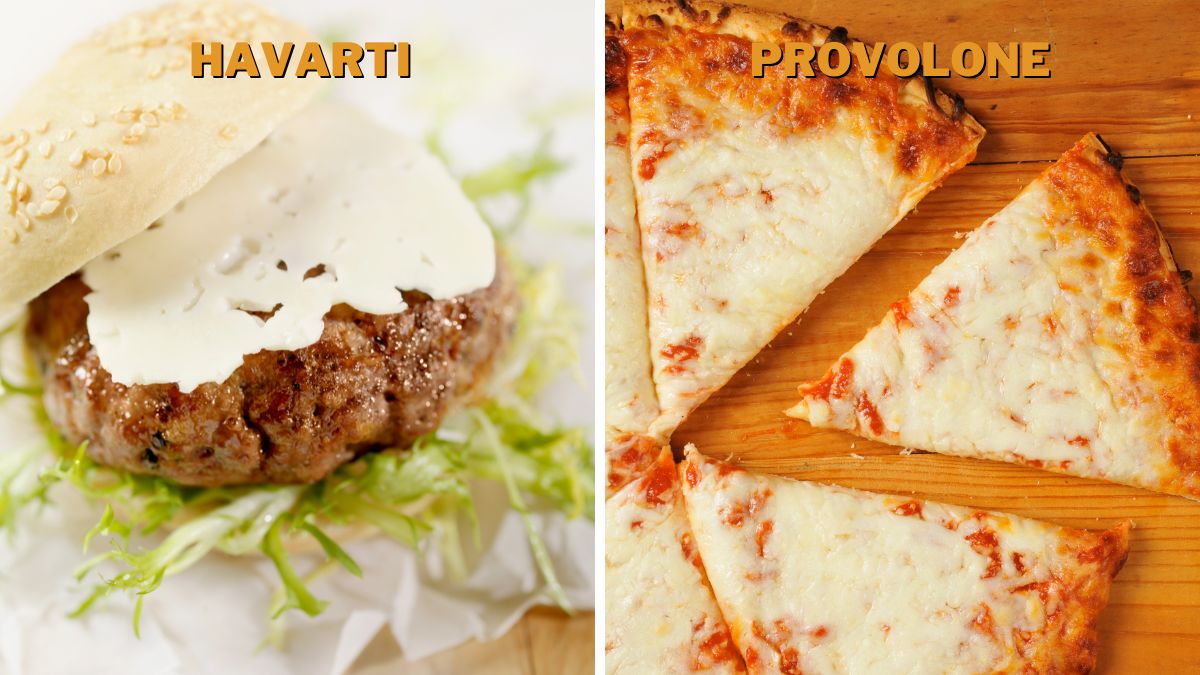Havarti vs. Provolone: Differences & Which Is Better?

Havarti and Provolone are similar but also have some significant differences. Both are white and have a similar taste, but the way they’re made and what they’re used for can make them taste different. When it comes to choosing cheese for sandwiches, we recommend you choose the cheese that best suits your taste. So, let’s have a look at the differences between Havarti and Provolone and decide which one is better!
While Havarti comes from Denmark, Provolone is an Italian cheese with a slightly sharper flavor than Havarti. Furthermore, Havarti is aged for a shorter period of time than Provolone, whereas the whole production process differs. While Provolone undergoes smoking or rubbing methods before aging begins, Havarti doesn’t.
Havarti and provolone are both delicious cheeses that are similar in many ways. However, they have some crucial differences that make them unique. Check them out.
Havarti vs. Provolone: Differences
Both Havarti and Provolone are among the most popular cheeses in the world. In the article below, you will learn about the differences between these two kinds of cheese and find out when to use one over the other.
Origins
Havarti is a cow’s milk cheese that originated on a Danish farm in the mid-1800s. The cheese was made by Hanne Nielsen, who learned cheesemaking techniques by traveling across Europe. Once she returned to Denmark, she started experimenting with how she washed the curds and created a creamy new cheese that she named after her farm, Havarthigaard.
Provolone cheese is an Italian semi-hard cheese made from cow’s milk. Its name derives from the Neapolitan words “prova” and “provola,” which mean “globe-shaped.” It originated from the Po River Valley in southern Italy and was introduced at the end of the 19th century.
Taste
Provolone usually comes in three different versions: Plain or smoked Provola, Provolone Picante, which features a sharper flavor and taste compared to the other two versions, and it usually has some similarities to the mozzarella cheese, and Provolone Dolce, representing the youngest and the sweetest version of this cheese.
Provolone is stronger in flavor than Havarti cheese and has a more earthy taste. Havarti features a buttery and creamy aroma and is one of the mildest and sweetest cheeses available. Besides, it is often flavored with various herbs, including hot peppers, horseradish, or dill.
Aging Process
Usually, Havarti needs a short aging process, which lasts about three months, but some varieties are aged more than a year and have a slightly saltier taste. Provolone gets its sharper taste from the long aging process, which, in Picante’s case, can last up to several years.
Melting Properties
Both Havarti and Provolone melt excellently. Moreover, Havarti cheese can be sliced, melted, or grilled, making it perfect for various recipes. When melted, you can easily use it in pasta dishes but use it when grilled for sandwiches.
Thanks to going through a plasticizing process that involves stretching the curd to reach the desired texture, Provolone has even better melting and shredding properties than Havarti. What’s more, it is great for grilling because it holds its shape when heated and doesn’t become runny as other soft cheeses do.
Nutrition
Provolone appears to have slightly better numbers than Havarti in a single serving, showing lower numbers of calories, fat, and carbs and a higher number of proteins. [1] However, these differences are not notable, so whichever option you choose, you won’t regret it.
Uses
Havarti is a popular table cheese that goes well on crackers. Moreover, due to its good melting properties, it can also be used for sandwiches or pasta dishes, and thanks to its sweet taste, it goes well with fruits, wines, and beers.
As an Italian cheese, it’s not surprising that Provolone is mainly used in Italian dishes such as calzones, pasta, or pizza. While Provolone Dolce is a fantastic option for a dinner or cheese platter, Provolone Piccante is perfect for antipasto or grated over soups, salads, and pasta, while Provolone Cheese is great melted on burgers or baked into lasagna.
This semi-soft cheese is also usually combined with other cheeses, such as mozzarella.

Production
The first steps for both cheeses are the same. First, the milk is separated into curds, which are then cut, and the whey is drained. The curd is then pressed into round cheese wheels and stored for aging.
The difference, however, lies in the steps that follow. In Havarti, the milk components are washed with salt water before being placed in the molds to attract bacteria that give the cheese its specific odor.
In Provolone, the curd is heated and stretched to achieve the desired texture.
Havarti vs. Provolone: Which Is Better?
Remember that both cheeses are delicious, and as with anything else, one may taste better than the other at a particular time and place.
However, if you’re paying close attention to nutritional values, go for Provolone. Havarti, on the other hand, has a milder taste and is, therefore, better combined with all kinds of dishes.
